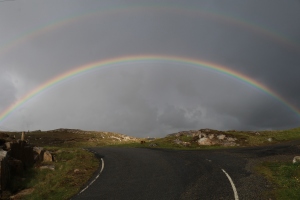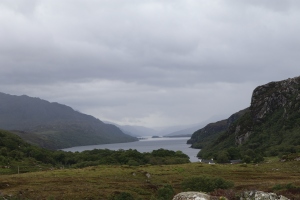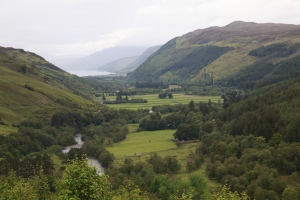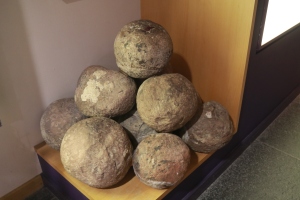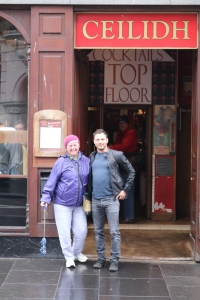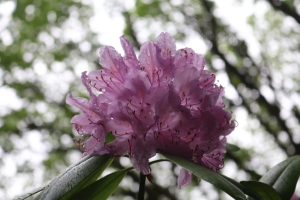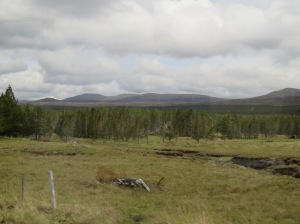Monthly Archives: June 2019
Lewis and Harris
These ‘pretend’ to be two islands, but in reality are one. The northern bit is Lewis. The southern bit is Harris. Allthego asked a youngish lady from the north if there was any difference in the people, she suggested the ones in the south were a little loopy. They seemed about the same to Allthego. We had arrived on Lewis and were staying in a Shepherd’s Hut at Mangersta on the west coast, in an area known as Uig. It is a relatively remote spot on farmland beside the sea. The farm grazes about a hundred sheep and an undisclosed quantity of Angus beef cattle. It is a rocky hilly place, but with plenty of green grass between the boulders. Totally unlike grazing lands in Australia, except perhaps for the south coast of NSW. As a base it is a good location because it is about equidistant from the east, north and south. An hour and half or so in either direction. In our 2 days on the island we went from one end to the other.
At the top, known as the Butte of Lewis is the unique red brick lighthouse blinking out into the Atlantic. The cliff tops here were the home to great flocks of Fulmers and Gannets, the northern cousins of the birds we saw along the Great Ocean Road in Victoria. The area going north is the locale of many of the ancient pictish brochs and standing stones sites. The stones at Callanash are the standout, high up on a hill overlooking a loch they dominate the skyline. Also, buses flock here and people wander among the stones looking them up and down and wonder why they are there. The stones look the people up and down and wonder why they are there. We are at the stones on the very day of the summer solstice and there are a number of vans parked near the site. Later, we hear that there is to be a celebration that night at the stones and all are welcome. One character suggests that they might even ‘put someone in a wicker basket and burn them’. Back at the Shepherd’s Hut our host tells us that her daughter was at the celebration, we saw her driving back the next day. May have been a wild night, Homealone didn’t want to try it out.
The Lewis Chessmen were supposedly found in the sandhills of one of the beaches at Uig. Quite a lot is made of this find of 12th century chess pieces made from bones. Chess sets of various sizes in most of the craft and tourist spots. We saw a set made of concrete, about 2 feet tall, at the Lewis Castle in Stornoway. Stornoway is the major population centre and were the ferry ports. We have also been extremely lucky to see among the boulders and grass a rare short eared Haggis. Lewis and Harris are believed to be one of the last remaining places were the short eared Haggis can be found in small numbers, a delightful little creature. The long eared haggis is much more common and is farmed on the mainland to supply the trade with meat.
Down in Harris is the strip of white sand beaches and rocky headlands one sees on postcards and calendars. It is quite a drive there and back through the boulder strewn hills and along the coastline. We stopped off at the Harris Golf Club, a nine hole links course ruining along the sea shore and headland. Great views over the beach at Scarista.
One of the features seen driving around are the ruins of many ‘blackhouses’. These were dwellings that many crofters lived in up until the early 1950s. Stone walls to about chest/head height, with blocks of peat on top of these and a thatched roof supported by wooden frames. Animals lived in one end during the winter and the family at the other. There was a central area with a fireplace, the main fuel being peat. It was very smoky inside, a small hole in the roof to let smoke out, no windows and therefore dark. We had a look through a replica of one of these, rather humbling experience. They were replaced in the 1950s by what are known as ‘white houses’ more substantial dwellings of stone and sloping thatched roofs and later slate. There are also ruins of these around, a number being renovated and modernised. New buildings are also modelled on the style.
It was hard to drag ourselves off Lewis and Harris, on our last day the sun had come out for us showing the colours of the island in a different hue. It is now back to the mainland and along the north west coast and around the top to John O’Groats.
Keeping moving
Well we are now heading off of Skye and bound for the Isles of Lewis & Harris. The day’s drive will take us to Ullapool where we join a ferry for the 3 hour transit across to Lewis. Allthego thought that it would be good idea to go back to the mainland from Skye by way of a ferry. If you can’t go ‘over the sea to Skye’ anymore then one should ‘go from Skye over the sea’ if you can. And, yes, you can do this. There is an historic ferry that goes from Skye to the small town of Glenelg on the Scottish mainland.
The ferry it seems is the last ‘rotating deck’ ferry in the world. It carries no more than 6 cars. It crosses a short channel at the southern end of Skye to Glenelg. In order to catch the ferry we need to traverse several miles of up and down single track road. It is not a very wide single track road and the passing bays seem to be a little further apart than the usual 200 metres. Allthego soon learns a trick though! Cars coming the other way come in batches of 6, being the capacity of the ferry. So we are able to get along at a reasonable pace and count cars. The road is a little steep in sections and not really for the faint hearted. But we made it and the ferry crossing successfully.
In Glenelg we sought out the local Broch ( pronounced ‘broc’). There are lots of these relics scattered around Northern Scotland, many of them just heaps of stones. The broch at Glenelg is one of the best examples of these structures remaining somewhat intact. They were a ‘flattened’ conical shape, about 5-10 metres high, with rooms for work, animals and living quarters in the sides of the structure. They were built extensively in the Highlands from about 2000BC to 100AD. The structures were defensive but were also demonstrative of the social status of those who lived within them.
The road from Glenelg then took us along the coast, with many great views of beaches and headlands before reaching Ullapool, where we stayed for 2 nights. Ullapool is a port town surviving very much on tourism and the ferry service to Lewis & Harris where we were now headed for 3 days.
Isle of Skye
We have arrived on Skye having crossed over the bridge. Quite an impressive bridge standing high above the loch. Allthego remembers the book ‘Ring of Bright Water’ written by one Gavin Maxwell; he studied it in high school English a few years back. It is about the author’s life on Skye and his relationship with some otters. The bridge has some of it’s stanchions standing on the island in the loch where the story is based. A visitors centre is nearby. It was tempting to go and see the place. But do you know what, we didn’t have the time to visit it. Too much else to see and do in the 3 days we had on Skye.
We based ourselves near a small village called Torrin on the south end of the island, a long way from anywhere. Quite long stretches of narrow single track road to reach it. Internet quite unreliable and sluggish. The Skye Mountain Lodge was a wonderful B & B. Great hosts and a great view across the loch to the Cuillin Mountains, some very impressive ‘black hills’ to wake up to. Frequently shrouded in mists, they did appear though from time to time. In the 3 days we experienced all of the weather patterns that Skye could throw at us, except snow. It did get quite chilly though! Some great sunny patches, particularly in the afternoons. The sun and clouds, some fluffy and white others dark and brooding, threw ever moving shadows that created unusual patterns and changing colours on the mountain slopes and valleys.
In our 3 days we set off on road trips to try to get around the major viewpoints and landmarks, both natural and human. Needed more time! But we gave it a good go and saw some wonderful things along the way. The Old Man of Storr, Kilt Rock, Fairy Pools, Dunvegan Castle and the lighthouse on the most westerly spot at Neist Point offered some of the most dramatic scenery.
The mountains and hills, the product of glacial scrapping were everywhere around us. One of the memorials to some early explorers on the island noted in awe the words of Pslam 121 ‘I to the hills will lift mine eyes from whence doth come my aid’. A very good description of the environment around us! Allthego and Homealone also enjoyed some good fish ‘n chips as well as mussels, the breakfasts were excellent at the B & B too!
Allthego could write much about this place, but he thinks that it is best left to others to do this. Pictures tell a thousand stories they say! We had a great time on Skye. We now head a bit further north for Ullapool and then by ferry to the Isles of Harris and Lewis, home of the famous Lewis Chessmen!
Over the sea to Skye
We are in Fort William for a day before heading a little north to the Isle of Skye. So the opportunity, having picked up our car, was taken to revisit the Glenfinnan Viaduct and Monument. The National Trust have a visitors centre in the valley below the viaduct curve and after a short walk up a hill behind the centre there is a good view of the Viaduct. Well, Allthego stood on the hill for 45 minutes to await the Jacobite train from Fort William. As did about 50 other people. Allthego stood his ground on a good vantage point despite some invasion efforts by other nationalities. All good. Anyway the locale was a little too distant for a good clear shot of the train, needed the longer lens which had been left behind in the car. The Glenfinnan Monument was erected in times past to mark the spot where Bonnie Prince Charlie had landed in about 1744, after coming over from France to pursue the restoration of the Stuarts to the Scottish and English crowns. The esteemed National Trust charge 4 pound to climb the tower, so Allthego didn’t. Others did, seems to be a good view from the top, where the Bonnie Prince stares north.
Earlier in the day Allthego had ascended Anoarch Mor in the gondola to try and get a view of the north face of Ben Nevis. Homealone did not venture up. It was pretty foggy up top when first alighting from the gondola car, not much to be seen. Fortunately, the air cleared a little and there was a good view down the valley to the lochs. But Ben Nevis was shrouded in the dreaded Scottish mist, so Allthego didn’t venture on the 40 minute return walk to the north face and returned down the mountain to the waiting Homealone, who had enjoyed a cup of tea.
Back at the Imperial Hotel we packed and rearranged a few things for the next stage of the journey; a road trip north to Skye and then onto the island of Lewis & Harris, before heading to the Orkneys and the Shetland Islands in the far north. The first stage to Skye covered some familiar ground, the journey took us up to Invergarry, along the shores of the Caledonian Canal and in particular Loch Lochy. On the way we passed by the Commando Monument which commemorates the role the region played in the training of British commando forces in WW11. Quite an impressive statue gazing out over the mountains. The weather was a bit crook, chilly and windy with rainy squalls. After passing through Invergarry, where we had had dinner whilst on the canal trip, the road out to Skye just rolled along beside the hills and lochs. It is marketed as a great drive, but the scenery was a little disappointing. There had been a lot of pine forest logging going on in recent times and the hills were significantly denuded in many places. A big replanting job will be required to cover the scars.
In a peaceful valley along the road there is a monument to the Glenshiel battle of June 1719. 300 years ago the Jacobites were defeated here by Government forces. There had been a memorial service a couple of days earlier, many tributes were scattered around the memorial stone. Memories are long in these parts! We also stopped in at the famous Eilean Donan Castle for a photo. It has featured in a number of TV shows and movies. On the maps the area is called the Kyle of Lochalsh. Allthego wondered what this meant. Seems to be that it is here that 3 sea lochs converge, Loch Alsh being one of them and the ‘kyle’ being the ‘straight narrow’ part of the loch.
A little later we caught sight of the bridge across the Loch to Skye. No longer a ferry trip and thus some of the locals think it’s no longer an island! We will just have to see!
Caledonian Canal (last part)
We are now heading back to Laggan to conclude our journey on the Caledonian Canal. It is going to be the same route, but a different experience. Mainly because the weather will be different! Our first stop will be the infamous Urquhart Harbour where we had that mooring hassle a few nights back. Looking forward to it! The trip down to Loch Ness from Inverness went quite quickly, the weather overcast and windless. No rain. The Urquhart Harbour presented no gremlins this time around and we neatly parked the vessel at the dock. All the onboard crew congratulated themselves several times over and wondered why it was so hard the first time.
The main attraction in this area are the ruins of the medieval Urquhart Castle. The Castle is situated on a headland jutting out into Loch Ness, it would have been an imposing sight in its hey day. We stepped ashore here and had a look around the ruins and notice boards explaining life in the castle. It was blown up by the Jacobites in order to prevent it’s use by Government forces. Later in the day we went into Doumnadrochit to investigate the Nessie Centre, the asking price for entry was a bit rich. So we bypassed it and headed into the small town for a look see and some refreshments.
After humming around for awhile and Homealone getting rather peckish we managed to contact the Clansman Hotel. They immediately sent their driver to pick us up (he was later to return us to the boat) and we headed back for dinner in their dining room overlooking Loch Ness. By this time the sun was out and it was a great view as the sun started setting. Excellent meal as well.
Setting off the next morning the objective was to reach Port Augustus in time to go up the locks. The weather had improved significantly and we had patchy sunshine as we traversed Loch Ness. We kept our eyes peeled for a Nessie sighting, but no, it was not to be seen. We concluded that some distant bow wave ripples might pass off for a sighting, so a number of photos were taken for later processing and investigation.
We made it in time for what was probably the last locking for the day at Fort Augustus. As we were down two crew Homealone volunteered to act as the 2nd mule for walking the boat through. This time around it was up the locks rather than down. Technique the same. We made it without any dramas and settled in for the night, ready for a quick getaway the next morning.
We headed off for Laggan the next morning in simply great weather, sunny, nice blue sky with some puffy clouds. Calm waters and a light a light breeze greeted us on Loch Oich and we slowly trailed behind some sail boats with their sales aloft. We cruised past the ruins of Invergarry Castle and the Hotel where we had enjoyed lunch and dinner a few days back. Our last stretch before the Laggan Locks was the magnificent so called ‘Laggan Avenue’, a narrow section of canal lined by pine trees.

This boat is styled a barge. It carries perhaps 20 passengers fully catered and guided up the canal. Somewhat more luxury than our boat!
After a short cruise out into Loch Lochie for a last look we returned to the Le Boat base. We stayed the night there and disembarked the next morning, handed the boat back, settled our account and took our pre booked taxi back to Fort William. The Watts were leaving us here and taking the train back to Glasgow for their flights home to Australia. It had been a memorable ten days on the Canal, with much to remember and recall with them and the Nielsens in a few weeks time.
For now though we settled into the Imperial Hotel for a couple of nights to regroup for the next stage of our journey in Scotland; over the sea to Skye.
Interlude in Inverness
We have reached the halfway point in our journey along the Caledonian Canal and are in Inverness. We now have to turn around and go back! Niel and Jackie are leaving us here in Inverness and heading off to Ireland. But first we are to have a brief wander around the city and see some of its sights, mainly those involving food. We don’t have much time to do anything else, apart from going out of town to visit the Culloden battlefield. Culloden was where in 1745 the last pitched battle took place on British soil.
The weather was also improving a little and we had a relatively clear day for the visit to Culloden. Khalid, a very Scottish sounding Pakistani taxi driver, advised us that it was going to rain the next day and that we should do outdoor things today. I asked him how he knew it was going to rain tomorrow. He explained that because it wasn’t raining today it would rain tomorrow. This was helpful.
The National Trust is slowly trying to ‘restore’ the battlefield environment at Culloden to what it was in 1745. No easy task given subsequent land uses and the passage of time. A guide took us around the site explaining the various positions taken up by the opposing forces and the basic battle strategy of both sides.
At its simplest interpretation the battle was between Government (English) forces with protestant ideals and the Jacobites (Scottish clans lead by ‘Bonnie’ Prince Charlie ) supporting the restoration of the Stuart dynasty (catholic) to the Scottish and English thrones. The visitors centre explains things in much detail and it was a lot more complicated than that. Scottish clansmen took part on both sides, the French helped the Jacobites. The religious differences were not as clear cut.
The Scottish clansman had a particular battle technique that previously proved successful against the Government forces. The Highland Charge, demonstrated in the photo below. The English traditionally stood in lines of three rows. The Scots would charge them and with their forearm mounted shield smash the first guy aside, slitting his throat with the upraised dagger in his left hand. Next the Scot would slash down at the second row with the claymore (big sword) in his right hand. The guy in the third row generally, ran away or so the Scot hoped! This technique worked well on firm ground, but here at Culloden it’s a bog. Enough said! Anyway, the Jacobites were routed and Bonnie Prince Charlie escaped back to France.
In the aftermath of the battle the English slaughtered all the injured and captured Jacobites. They were later buried in various mass clan graves in unmarked pits. Years later clan names were engraved on stones placed near the pits. It is not really known whether the clan names match the pits. It was also a period when laws were introduced in an attempt to supress and wipe out the clan system in Scotland, hoping to prevent future uprisings. The population was heavily suppressed and controlled by English land holders, culminating in the Highland population clearances. Many emigrating to Canada, US and Australia. Please refer to Wikipedia for more on this and any thing else about the Jacobites. There remains in Scotland today this feeling that the English are, well, the English and the Scots are the Scots. Culloden feels a bit like the Civil War battlefields we have seen in the United States. The battles just don’t seem to have been finished!
After all this education it was back to the present, a farewell lunch and then the boat for the trip back down the Caledonian Canal the next day.
Caledonian Canal (another part)
Do have to share an earlier picture and story with you about the ‘Eagle Barge’ at Laggan locks. The Eagle Barge is unique. It is the only floating hotel on the Canal. As such it demanded our attention. It was booked out for dinner. But we could squeeze in for a bar snack and beverage. Well, was it an interesting place and a study in service technique. The first trick we saw was when a keg went dry and the young lady behind the bar man-handled the replacement keg into position. Very impressive sight indeed! Though the beer was rather flat and very warm. The second trick was to charge 8 pounds for 3 half pork (dubious) sausages and a scoop of chips and get away with it! Niel, Jackie and Tony obviously enjoyed the ambience of the location and the sprawling lounge chair, despite the sluggish service.
Now back to the journey.
After leaving our mooring at Invergarry we continued up Loch Oich to Fort Augustus, about half way along the canal system. Here, there is a staircase of 5 locks and a swing bridge to navigate down into Loch Ness. We arrived before lunch and decided to stay at the top of the locks and go down in the morning, mooring at the bottom for a late breakfast. This would give Jackie spare time to do some washing ashore. Have to think of these things.
Fort Augustus is a pleasant little town, very focussed on tourism. Shops, pubs and eateries line the canal staircase. Numerous travellers gaze down from the sidelines as the boats move through the locks, lots of Chinese tourists here on bus tours taking in the sights. A busking bagpiper rendering ‘A Scottish Soldier’ and other ditties kept passers by entertained.
It takes about an hour to go down the locks. The operation is a little different to others in that we have to drag our boat from lock to lock, one on the front rope and one on the back rope with no engine power assist. A bit like mules hauling wagons. Not as hard as it might appear as once you get the boat going it glides along relatively easily. We got through without any problems and as planned enjoyed breakfast at the bottom with views down Loch Ness. Jackie eventually got her washing done. Jackie took a bit longer than usual. Bit slow (90 minutes) in discovering that the spin dryer, despite her using detergent, does not wash clothes. On the journey though Jackie excelled in the galley, with a lamb stew, a chicken casserole, spaghetti bolognaise and some excellent Cumberland sausages and vegetables.
After breakfast we headed off into the Scottish mist down Loch Ness, it was 37 km to Inverness with a night stop over along the way at Urquhart Harbour, below the ruins of the old castle. No sightings of Nessie on the loch. Allthego had taken the wheel here for the attempted mooring in the Harbour, in somewhat windy conditions. He was wanting to hone his reversing skills into narrow moorings between other boats. It was a minor disaster. Despite an impressive approach the finish was ruined by over exuberance on the throttle, forward and reverse, combined with bow thruster efforts and cutting of the engine. One of our neighbouring boats was gently nudged and the dock knocked backwards a bit. No pictures. No damage. Bruised ego.
In the morning we completed the short passage to Inverness for a two night stopover.
Caledonian Canal (Part 1)
It has been one of Allthego’s bucket list items to do a boat trip on the Caledonian Canal. What better reason to come to Scotland. The Canal connects the Scottish west coast at Fort William in the south to the east coast at Inverness in the north. It is 97 km long. Built in the early 19 century, it took about 20 years to construct and was completed in 1822. The man made portions of the Canal link a series of natural lochs (or what we would call ‘lakes’) together, in what is known as the Great Glen. The most famous of the lochs is Loch Ness. There is roughly 30 km of man made canals and around 65 km of natural lochs. Loch Ness is inhabited by Nessie, which we hope to sight in due course. There are a few (12) large locks to navigate through as we move along the canal, we are not allowed to go down the staircase locks into the sea at either end.
The canal was built to provide a trade route between the east and west coasts that would bypass the dangerous sea route along the Scottish west coast and around the top near the Orkney Islands. The Canal construction was also to provide a source of employment in the Highlands and protection to shipping from the ravages of French privateers. The threat of Napoleon also influenced the English Navy to support the project. When the Canal was completed though, Napoleon had already been defeated and the Navy didn’t need to use it. Ship building had also advanced and the new steam driven iron hulled ships were too big to use it. Today, it is a recreational canal for folks like us and also a safe route for sailing enthusiasts moving from places like Norway in the North Sea down to the northern Atlantic and Irish coasts.
To undertake our journey we have hired a modest motor cruiser that will reasonably accommodate the 6 of us in 3 berths, with a spare one to hold luggage. All up we are onboard for 10 nights and had 8 days on the water. The plan was to cruise the length of the canal. The journey started at Laggan about a third the way up the canal, so the first cruising day took us back down the Canal through Loch Lochy to Fort William where we promptly turned round and set course for Inverness, setting course wasn’t that difficult as you just pointed the bow straight ahead most of the time. Overnight, we moored alongside pontoons or in small harbours. Generally, we were able to hook up to water and power.
We set off in pretty terrible weather; cold, windy and scattered rain squalls. It was like this for the first 3 or 4 days. However, into the afternoons, the weather cleared a little and we were blessed with some patchy sunshine.
There was considerable merriment onboard despite these conditions. Good humour abounded and what happens on a cruise stays on a cruise. So the saying goes. Niel’s efforts with the fishing line were rewarded with 2 eels, they were returned to the water to live another day. On our third night we found ourselves moored near the ruins of Invergarry Castle. Nearby was the Glengarry Hotel overlooking Loch Oich, a small loch between Loch Ness and Loch Lochy. We had lunch in the Hotel, a wonderful old building with great eating areas and views over the Loch. Invergarry Hotel, another short Scottish walk away, beckoned for dinner. Great old pub setting, food excellent!
The landscape along the Canal is outstanding. In the early stages we have views of Ben Nevis (Scotland’s highest peak), still with small patches of snow on its northern face. As we progress the mountains continue to line both banks, covered in plantation pine trees and naural vegetation. In the foothills and along the flats beside the Lochs there are small farming operations and plenty of black faced sheep in the lush green paddocks. The weather drapes the mountain ridges and valleys in layers of cloud and mist, sometimes an eerie atmosphere prevails. Great contrast with the clear blue sunny skies of the publicity brochures, postcards, calendars etc. We all think it would be good to see some of those too!
Perphaps the new day will bring some on.
I’m Back!
Been away for a few days, but we are now back in Fort William. The six of us have completed the boat trip up and back down the Caledonian Canal. The Nielsens left us in Inverness and headed off to Ireland and the Watts are on their way back to Australia. The internet along the canal was not conducive to blogging so Allthego now has a few updates to complete and will try to get back to real time over the next few days. More on the canal experience in the next post.

From the right the Watts, then Browns and Niel Nielsen in red cap at left, Glasgow Queen St Station. Setting off for Fort William,
We arrived in Fort William from Glasgow by train along what is known as the West Highland Line. This is a rather spectacular train journey through the Scottish landscape. Leaving Glasgow we travelled along beside the Clyde River, before rising into the Highlands. Up here we ran high above the shores of lochs far below, through what is almost rain forest. Past a nuclear submarine base and later the storage caves of their trident missiles. Later we crossed Ranoch Moor, in some places the train line runs on rails ‘floating’ on foundations made from wood and ash. It’s pretty damp and boggy on the moors! We go along at a fair pace and it is hard to capture images of the scenery through the windows and ‘Scottish mist’, code for rain and fog.
Along the way we all indulged in some light snacks and enjoyed impromptu entertainment. Tony Watt it transpires is somewhat skilled at splitting apples. But not ones that are a bit on the floury side. He needs crisp ones. Anyway he managed to lay a finger across an apple and then smash down with his other hand upon said finger. Made a bang! Instead of splitting in two the apple shattered. Homealone across the aisle took a sharp catch of a piece, a lady in a seat behind had a piece whistle past her and the rest just sought of flopped on the table. Fairly humorous at the time!
Eventually we arrived in Fort William. It was dry and we set off for our accommodation pushing and pulling our bags down the short stroll to Ashburn House, overlooking Loch Linnhe. It was a lengthy ‘short’ stroll and we eventually collapsed into the B & B. Great B & B with an excellent breakfast set up overlooking the Loch. We had a very comfortable three nights here. Bit wet and damp though which was disappointing. The previous summer in Scotland had been unusually dry and April this year had followed the same pattern. But May, well May seems to be doing the catching up.

Neptunes Staircase takes boats from the sea waters of Loch Linnhe up 8 locks into the Caledonian Canal. The white structure is a railway swing bridge and behind it is a road swing bridge, All need to open to let boats up into the canal.
We spent our first day in Fort William having a look around town, and then walking along the first stretch of the Caledonian Canal from the sea locks on Loch Linnhe up to Neptune’s Staircase. Rather cold, windy and damp at times. Enjoyed hot chocolates at the café beside the canal.
The highlight in Fort William was the 84 mile round trip steam train journey on The Jacobite to Mallaig and back. It was misty, wet and cold but the journey was memorable. Particularly, the crossing of the 1898 Glenfinnan viaduct. 21 Arches overlooking Loch Shiel and made ‘famous’ in the Harry Potter movies. After an early pub dinner in Mallaig, the train stops there for an hour and half before returning to Fort William, we arrived back at Ashburn House to prepare for our taxi ride the next day to Laggan and the start of the cruise on the Caledonian Canal.





